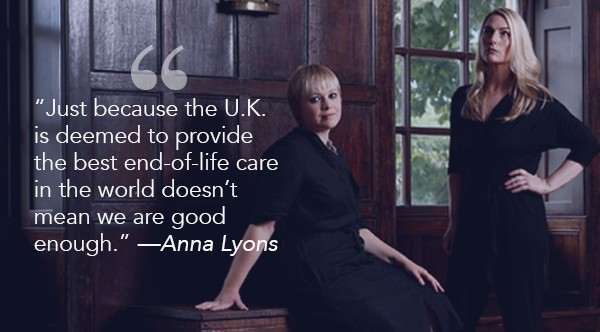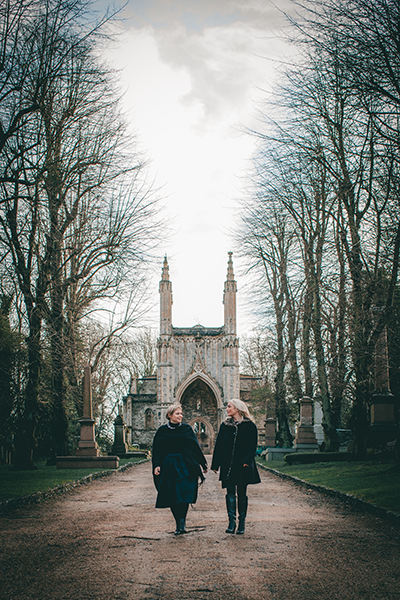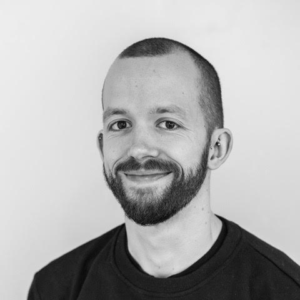EOL Innovators in the UK: Creating Communities of Care for the Living and the Dying
EOL Innovators in the UK: Creating Communities of Care for the Living and the Dying
By Liana L. Chang
As the birthplace of the modern hospice movement, the natural burial movement, and Death Cafe, it’s unsurprising that the U.K. has earned a global reputation as “the best place in the world to die.” But according to Anna Lyons, end-of-life doula and coauthor of the recently published book We All Know How This Ends: Lessons About Life and Living From Working With Death and Dying, “Just because the U.K. is deemed to provide the best end-of-life care in the world doesn’t mean we are good enough. It just means we are not as shit as the rest of the world.”

photo by John Phillips
This dry and knowing statement manages to capture a quintessential attitude of the British—pragmatic and self-effacing—that is helping those in end-of-life care reach the goal of ensuring that, as Lyons puts it, “end-of-life care is recognized alongside curative care as a basic health care right” and made freely and widely available to anyone who needs it.
Although Britain’s National Health System (NHS) provides free health care to everyone living in the U.K., only 30% of hospice funding comes from the government, with the remaining 70% covered by charity. The challenge to fully integrate hospice care into the NHS is a daunting one, as Lyons’ coauthor, Louise Winter, a progressive funeral director, well knows. “In death, you never get a do-over,” Winter says. “How people die really informs how others grieve.”
Together, the two have become important figures in the U.K.’s death awareness movement (they empathetically never use the terms “good death” or “death positivity” to avoid placing a judgment or agenda on people’s ability to define their own experience). As the duo behind Life. Death. Whatever., an initiative to redesign the dialogue everyday people have about death and dying, Lyons and Winter’s work over the past six years has spawned the aforementioned book, numerous events, talks, exhibitions, and a vibrant social media following @lifedeathwhat of more than 47,000 people—one of the largest grief support accounts on Instagram. It is their hope that “the more people engage with death before they have to face it, the more they know what to expect. The more they know what to expect, the more power they have.”
A Devastating Pandemic—and a New Opportunity

photo by Melissa Rodrigues Photography
In the first year of the COVID-19 pandemic, the U.K. suffered some of the highest mortality rates in all of Europe and endured many months of strict lockdown and social isolation rules. During that time, many folks found themselves mourning alone in their homes. Those in the know found guidance and comfort online in the vibrant and inclusive community Lyons and Winter have built, where conversations about death and dying need not be carried out in hushed tones, oblique metaphors, somber colors, and stock photos of the smiling and silvered elderly.
Their Instagram community is that rare space on social media which is both rich in wisdom and free of judgment and pretense. Through their “Five Things” series, which welcomes writing from anyone, many contributors choose to share their personal experiences—the death of loved ones, the pain of baby loss, the planning of funerals, the cruelty of suicide—publicly rather than anonymously, in hopes that their hard-won wisdom might help themselves and others heal. In providing such a space, Lyons explains that Life.Death.Whatever., “lets people know that it’s OK to feel what they’re feeling, that they’re not alone in their grief. We may have lost the physicality of grieving due to COVID, but for now, it’s important that people know that at least online, there is a real support system out there when they need it.”
A recent study by the Marie Curie foundation suggests that the COVID-19 pandemic led to an overall 41% increase of people dying at home in the U.K. This phenomenon has indirectly enabled a long-term aspiration of increasing the proportion of people who die at home to be realized. One community nurse from the study observed, “I feel more patients stayed at home for non-COVID related end-of-life care. Which was good. I think the staff that were at the front line went above and beyond to keep patients at home. Patients and families did not want admission as then they could not see family, etc., and then die without family there. Staying at home was seen as the best option for most patients and families, even if it was tiring.”
John McGrath, chairman of Cicely Saunders International—the nation’s foremost research institute for hospice care and the namesake of the doctor and visionary who pioneered modern hospice care—observed in the most recent quarterly newsletter that, “We have seen demand for palliative care surge, reaching levels of need we previously only expected to be reached in 2040. This has highlighted shortcomings in the palliative care system, compromising patients’ care and affecting families and carers.”
Designing for Better EOL Care

Courtesy of Ivor Williams
For Ivor Williams—a startup advisor at the social good incubator and venture capital firm Zinc and senior designer at the Helix Centre, a cutting-edge research institute and digital health innovation lab situated on the grounds of St. Mary’s Hospital in London—those shortcomings have provided a wealth of opportunities for design and technology to bring new innovations to end-of-life care.
“Currently, the likelihood of a person being able to remain at home during their end stages of life is often dependent on the availability of carers beyond the health care team—usually a close family member or friend,” Williams says. “Carers have the capabilities to do so much. How do we use tech and design thinking to recenter what the patient and carer needs rather than what’s convenient for the pharmacist or physician?”
At Helix, that question is being answered by innovations such as a new digital support app, currently in pre-pilot stage, called Palliate. The app seeks to empower carers—a common British term equivalent to “caregivers” in American English—to deliver end-of-life care and pain relief medication (including those needing subcutaneous administration) at home, reducing the need for dying people to be in hospice or receive pain management treatment in an emergency room.
Williams also advises the startup Untangle, a social network app helping people cope with grief by matching mourners to others in their area to create community-based support groups. Untangle offers free events, expert advice, and other bereavement services ranging from recommendations on how to save money on funerals to how to ask for time off work in order to grieve. Since its launch in early 2020, with the help of a government grant for businesses focused on addressing new needs arising from the COVID-19 pandemic, Untangle has seen its membership grow rapidly.
But that growth doesn’t necessarily indicate a new need—its cofounder, Emily Cummin, stated in an interview not long after Untangle’s launch that most of the community’s new members were people “who maybe lost someone a while ago and hadn’t dealt with it but because of coronavirus and the real presence of grief in society at the moment, suddenly this past grief is coming up,” driving them to discover communities of support online.
Williams’ work is guided by a belief that “Western end of-life care is in need of ‘reverse innovation,”—a seemingly counterintuitive vision for someone working at the bleeding edge of tech. “The future of health care is one that deprofessionalizes and decenters death and dying from medical care to community care,” Williams says. He points to the groundbreaking community model of palliative care in Kerala, India, as producing better outcomes than standard health care services.
A Simple, Community-Led Model With Remarkable Results
Williams also looks toward the work of Dr. Julian Abel, director of Compassionate Communities, a U.K. organization that seeks to address the morbidities so often associated with loneliness and isolation by working with communities to build compassion and connecting the grieving, the elderly, and those living with life-limiting illness and their carers with local networks and resources. One of the organization’s projects, launched in 2013 and known as the Frome Model, after the area of the U.K. where the work was pioneered, has brought a low-tech approach to cultivating connections and social relationships. By employing “health connectors” to help patients plan their care, and by recruiting and training neighborhood volunteers to act as “community connectors,” people in the Frome Model have been better able to find the support most relevant to their needs.
The modesty of the intervention belies the remarkable results the organization has produced—a 15% reduction in emergency hospital admissions, while the wider region’s admissions increased by 30% over the same period. Results such as these were the first-ever successful intervention of their kind in reducing emergency admissions. If rolled out successfully across the U.K., it offers the tantalizing possibility of helping to alleviate the current national health crises of overcrowded emergency rooms and strained budgets, while also increasing civic engagement toward the creation of a kinder, more connected, and engaged society.
The implications of these U.K.-based movements poses an intriguing question for INELDA and others in the end-of-life space. As doulas, we are clear on where our work ends, but where might our work begin in order to have the greatest impact on the lives and deaths of the people and populations we wish to serve? As community organizers or policy advocates? As artists or app developers? As classroom educators or social media influencers? Truly, in the words of Williams, “the opportunities for innovation at the end of life are limitless.”
Bio: Liana Chang is an organizational leadership coach, business consultant, and end-of-life doula who considers many cities in different countries—including Tokyo, where she currently lives—to be home. She is passionate about helping people explore life’s most challenging and beautiful questions.
